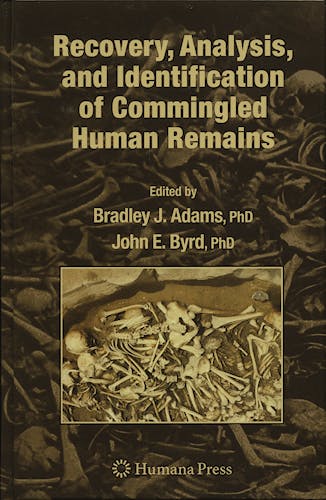

No hay productos en el carrito



Recovery, Analysis, and Identification of Commingled Human Remains
Bradley, A.
1ª Edición Febrero 2008
Inglés
Tapa dura
374 pags
1200 gr
16 x 25 x 3 cm
ISBN 9781588297693
Editorial HUMANA PRESS
LIBRO IMPRESO
-5%
155,99 €148,19 €IVA incluido
149,99 €142,49 €IVA no incluido
Recíbelo en un plazo de
2 - 3 semanas
Mass fatality events can result in the intermixing, or commingling, of human remains. Commingling of human remains presents an added challenge to all phases of the forensic process. As the number of individuals increases, so does the complexity of the forensic investigation and the skills needed for case resolution. In Recovery, Analysis, and Identification of Commingled Human Remains, top professionals illustrate successful techniques for sorting and determining the number of individuals, the role of DNA, ethical considerations and data management. Instrumental to the forensic community, Recovery, Analysis, and Identification of Commingled Human Remains provides case examples and an in depth review of experiences, methods, and research related to commingling.
Written for: Professionals and graduate students in Forensic and Anthropology, Forensic Pathology Professional/medical student, Forensic Odontology Professional/dental student, Forensic Biology Professional/graduate student and Disaster management Professional
Table of contents
Methodology in Commingling Analysis: An Historical Overview
Douglas Ubelaker
Spatial Analysis of Mass Grave Mapping Data to Assist in the Reassociation of
Disarticulated and Commingled Human Remains
Hugh Tuller, Ute Hofmeister, Sharna Daley
Pieces of the Puzzle: F.B.I. Evidence Response Team Approaches to Scenes with
Commingled Evidence
Gary Reinecke and Michael Hochrein
Commingled Remains and Human Rights Investigations: Challenges from the Field
Sofía Egaña, Silvan Turner, Mercedes Doretti, Patricia Bernardi,
and Anahí Ginarte
Anthropological Investigations of the Tri-State Crematorium Incident
Dawnie Wolfe Steadman, Kris Sperry, Frederick Snow, Laura Fulginiti, and Emily
Craig
Approaches to Commingling Issues in Archeological Samples: A Case Study from
Roman-Era Tombs in Greece
Douglas Ubelaker and Joseph Rife
Anthropologist Directed Triage: Three Distinct Mass Fatality Events Involving
Fragmentation of Human Remains
Amy Mundorff
The Use of Radiology in Mass Fatality Events
Mark Viner
Detection of Commingling in Cremated Human Remains
Michael Warren
Models And Methods for Osteometric Sorting
John Byrd
Patterns of Epiphyseal Union and Their Use in the Detection and Sorting of Commingled
Remains
Maureen Schaefer
How Many People? Determining the Number of Individuals Represented by Commingled
Human Remains
Bradley Adams and Lyle Konigsberg
Assessment of Commingled Human Remains Using a GIS Based Approach
Nicholas Herrmann and Joanne Bennett Devlin
The Application of Traditional Anthropological Methods in a DNA-Led Identification
Process
Laura Yazedjian and Rifat Kešetovic
Marrying Anthropology and DNA: Essential for Solving Complex Commingling Problems
in Cases of Extreme Fragmentation
Amy Mundorff, Robert Shaler, Erik Bieschke, and Elaine Mar-Cash
Sorting and Identifying Commingled Remains of U.S. War Dead: The Collaborative
Roles of JPAC and AFDIL
Franklin Damann and Suni Edson
Resolving Commingling Issues during the Medicolegal Investigation of Mass Fatality
Incidents
Elias Kontanis and Paul Sledzik
Data Management and Commingled Remains at Mass Fatality Incidents (MFIs)
Michael Hennessey
© 2025 Axón Librería S.L.
2.149.0